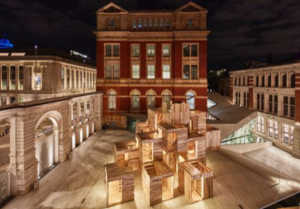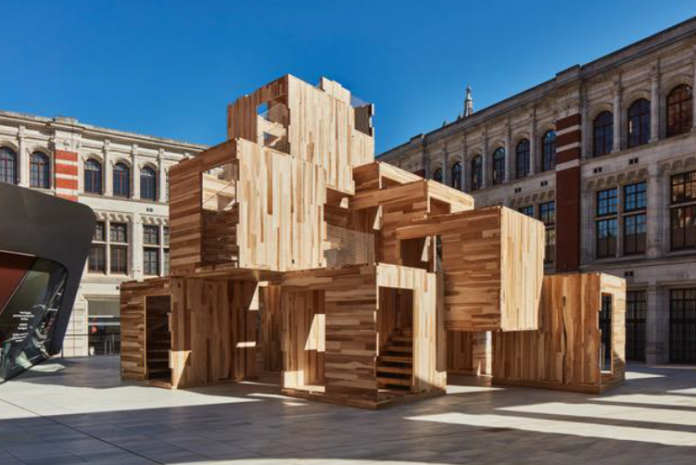A nine-metre high, carbon-neutral wooden pavilion made from American tulipwood opens to the public in the Sackler Courtyard of the V&A in time for the London Design Festival on 15 September
The 43m3 of tulipwood that make up MultiPly store the equivalent of 30 tonnes of carbon dioxide and are replaced with natural growth in the American forest in five minutes and will remain at the V&A until the beginning of October.
Installed by Waugh Thistleton Architect, the American Hardwood Export Council (AHEC) and ARUP, the structure shows how modular cross-laminated construction in hardwood is a viable solution to the current housing crisis.
The structure is made with the first UK-manufactured cross laminated timber (CLT) panels.
Multiply is one of London Design Festival’s Landmark projects and is comprised of a maze-like series of interconnected spaces that overlap and intertwine.
The wooden arrangement has been constructed from 17 modules of American tulipwood CLT with digitally fabricated joints and was assembled in under a week like a piece of flat-packed furniture.

The design was intentionally built out of modules to be reassembled elsewhere after the London Design Festival.
Andrew Waugh, co-founder of Waugh Thistleton Architects said: “The main ambition of this project is to publicly debate how environmental challenges can be addressed through innovative, affordable construction.
“We are at a crisis point in terms of both housing and CO2 emissions and we believe that building in a versatile, sustainable material, such as tulipwood, is an important way of addressing these issues.”
To keep up with population growth and deal with years of under supply, around 250,000 new homes would need to be built in the UK every year. In 2016/17 184,000 new homes were built in the UK, a shortfall of approximately 66,000 homes.
David Venables, European Director of AHEC commented: “Waugh Thistleton Architects has been pioneering innovative uses of wood in construction for decades.
“‘MultiPly’ explores a new, more sustainable way of building, bringing together a readily available carbon-negative material – American tulipwood – with modular design.”
Tulipwood is sourced from the Eastern United States, where the hardwood forest area is expanding at a rate of one football pitch every minute, and already exceeds 110 million hectares, equivalent to the combined area of France and Spain.














